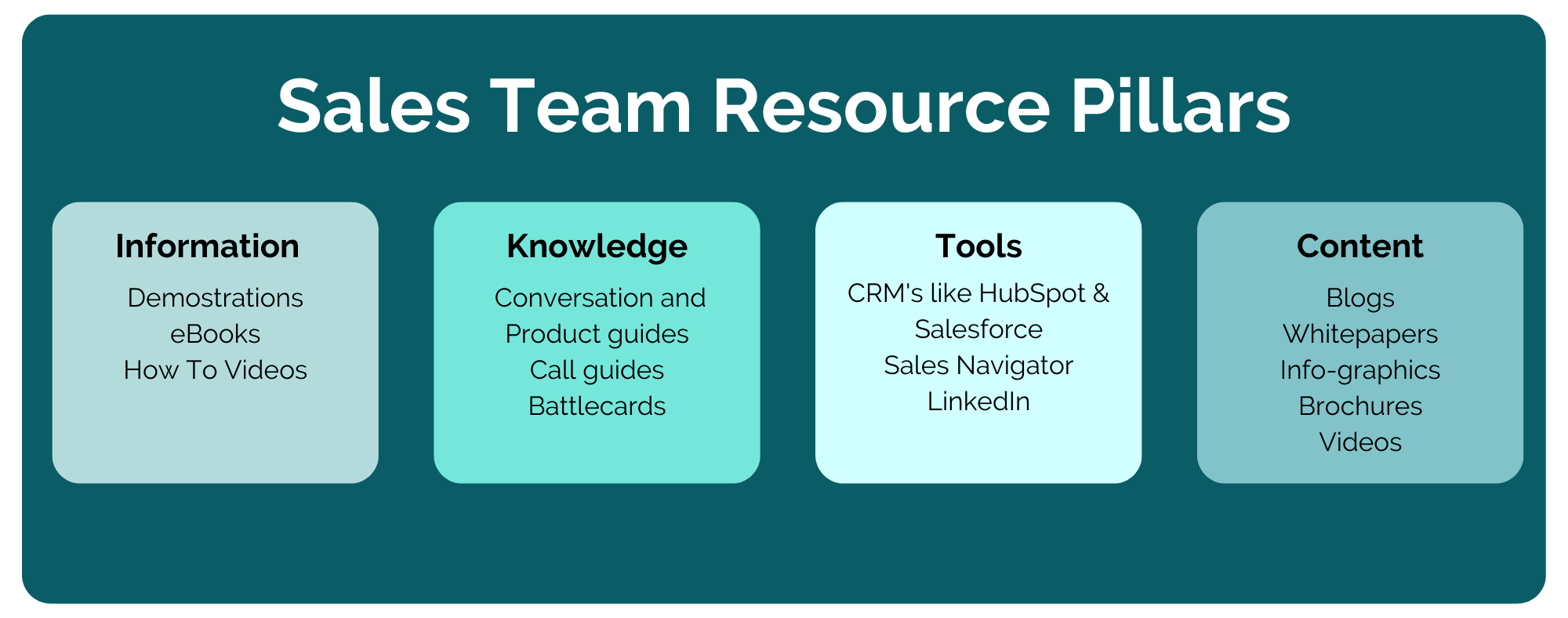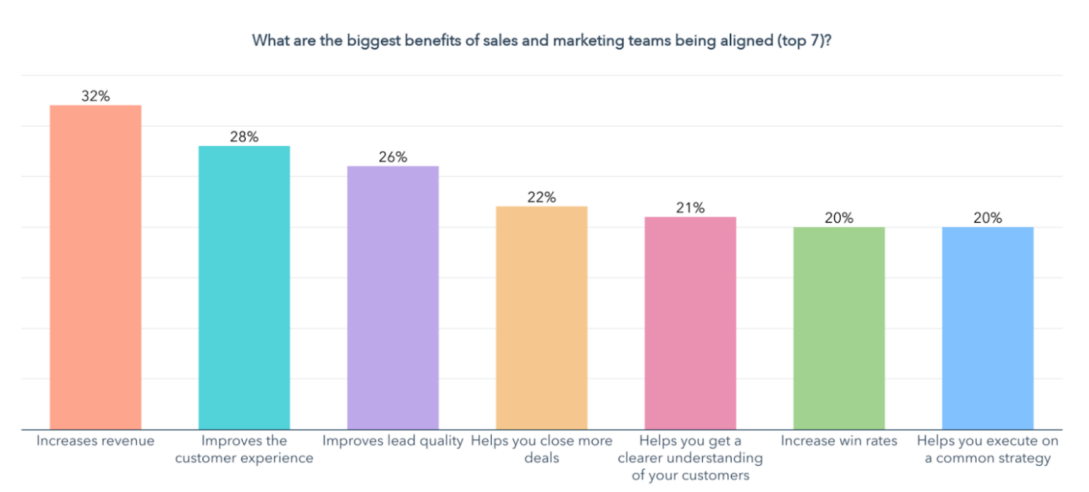The fact you have landed on this blog is a clear sign you are looking at building a sales enablement strategy or improving your current process. The most common consequence of not utilising sales enablement is an unprepared sales team that lacks the content, skills and tools to efficiently sell.
Did you know that 95% of buyers purchase from the person who gave them the content (regardless of the stage in the buying process)? However, 65% of sales representatives say they don’t have access to content to send to prospects.
Implementing sales enablement technology ensures sales teams can quickly access new, relevant and latest content; including video, presentations, PDFs, etc. With such content so readily available, the sales representative can mix and match different types of content to create a customised experience for each individual sales interaction.
What is sales enablement?
HubSpot defines it best. Sales enablement is the repeated process of providing the sales team with the resources they need to close deals. Typically, these resources include the four pillars of content, tools, knowledge, and information. By combining these elements, the sales team can be armed with the best chances to convert prospects.

Addressing Common Sales Challenges with Effective Sales Enablement
The latest Sales Report by HubSpot highlights common challenges faced by sales teams that can be addressed through an efficient sales enablement strategy; challenges include increasing market share, streamlining the sales process, and aligning sales and marketing departments.
Challenge One: Winning More Market Share
Six out of 10 sales leaders strongly emphasise the importance of having sales enablement assistance in winning marketing share. In fact, salespeople working in companies with dedicated enablement teams tend to perform better. When sales enablement and marketing teams establish a strong presence in the market, it greatly facilitates the sales process.
Sales leaders highly recommend collecting essential sales enablement materials:
- Product demos that highlight practical use cases.
- Up-to-date customer testimonials and case studies that showcase successful outcomes.
- Reviews that demonstrate positive customer experiences.
- Current market research reports to stay informed about industry trends.
- Shareable social media content that amplifies brand visibility and engages the target audience.
Challenge Two: Making the Sales Process More Efficient
With increasing customer expectations, sales representatives need to expand their discovery checklists, resulting in additional time and administrative tasks in their day-to-day. A significant portion (29%) of sales professionals responded on a HubSpot report, that their primary goal for 2023 was to enhance the efficiency of their sales process.
Over 20% of sales professionals reveal that prospects often abandon deals due to the lengthy sales process. Therefore, taking measures to accelerate approvals and timelines not only helps distinguish oneself but also boosts the chances of successfully closing the deal.
Exploring sales enablement examples that support the sales process:
- Create a certain number of content pieces designed around the needs of a persona.
- Introduce a new technology to support the sales teams' efforts, for example, HubSpot Sales Hub.
- Ensure the sales team is fully trained on the company's CRM, utilising all the powerful sales tools available.
- Host informative webinars for prospects and invest in attracting attendees. This is a great opportunity to showcase the solution, increase brand awareness, establish yourself as an industry expert, lead nurturing and build thought leadership.
Challenge Three: Improving Sales and Marketing Alignment
When there is a lack of alignment between sales and marketing teams, it results in various negative outcomes such as missed sales opportunities, reduced revenue, loss of qualified leads, and a negative impression of the company, (HubSpot Sales Report 2023).
- A significant majority (52%) of salespeople acknowledge that misalignment between sales and marketing teams has directly impacted their revenue.
- While more than one-third (36%) state that it hinders the success of both teams.
- Furthermore, a considerable portion (33%) of sales leaders observe that when sales and marketing are not aligned, it leads to wastage of the marketing budget.
How To Align Marketing and Sales for Successful Sales Enablement
1. Build a Partnership by Increasing Cross-Department CommunicationPromoting constant communication between sales and marketing departments under strong leadership is essential. This involves marketing actively engaging with sales teams, seeking their feedback, and incorporating it into the development of sales assets, ensuring that the messaging, concepts, and language align with their requirements instead of marketers making those decisions independently.
2. Agree on the Ideal Customer ProfileBy establishing a shared understanding of the ideal customer profile (ICP), teams can effectively guide users through the sales funnel and accurately identify qualified leads. This collaborative effort results in a shortened sales cycle and a better understanding of the overall impact on the sales funnel.
3. Build Agile ContentTo prevent the accumulation of unused assets, marketers should utilise agile content that can adapt to changing markets and keep sales teams well-informed. By incorporating insights from the sales teams, dynamic content can be developed, enabling sellers to actively participate in the creation of marketing materials.
A healthy sales and marketing alignment is built through transparent and balanced sales enablement goals and data. Properly implemented sales enablement initiatives enhance sales knowledge, track sales effectiveness, and improve sales productivity. All while highlighting areas of improvement.
When sales and marketing teams are aligned, your company could experience benefits:

Benefits of Implementing a Sales Enablement
Sales enablement enhances the alignment of sales, marketing and support departments by implementing a standard process that is adopted throughout the company.
Key benefits include:
- Ensuring cross-department alignment and cooperation so the company can benefit from shared insights.
- Increase sales team efficiency by arming them with the best practices when approaching prospects, battle cards, assigned training, and useful templates. If done well, sales enablement can offer sales teams more value in their pitches and prospecting efforts.
- Improved customer experience as the prospect is exposed to a more cohesive experience throughout the stages of their buying cycle.
- Intelligent buyer interactions. It is the job of a sales enablement strategy to answer these key questions; how do we manage each touchpoint, how to personalise every customer journey, and how to approach sales conversation with the intelligence and foresight the sales team needs? (Showpad). Sales enablement works because it helps remove the guesswork of prospecting.
With the support of comprehensive sales data, the sales team gain a sense of assurance and authority in every sales interaction, empowering you to guide prospects effectively.
How to Build a Sales Enablement Framework That Drives Results
Establishing a well-designed sales enablement framework can improve outcomes and drive business growth. The process of building a sales enablement framework is explored more here:
Step 1: Define Your Sales Process: Begin by clearly defining your sales process, highlighting the stages from lead generation to deal closure. This step clearly identifies areas where additional support or resources are needed.
Step 2: Identify Your Sales Enablement Goals: Align your sales enablement goals with your overall business objectives, such as revenue growth or increased market share. For example, a sales enablement goal could be to shorten the sales cycles.
Step 3: Develop Your Sales Enablement Strategy: Build a sales enablement strategy that aligns with your business objectives. This strategy should incorporate the necessary resources, tools, and information to empower your sales team. For example, sales training materials and competitive intelligence reports.
Step 4: Implement Your Sales Enablement Framework: Put your sales enablement strategy into action by implementing the framework. This may involve creating and distributing sales enablement content or providing training and coaching.
Integrating technology tools to support the sales process is another action to help support the sales team in implementation. By recruiting a CRM technology like HubSpot that is purpose-built for sales enablement processes, historically manual processes can now be automated for sales teams, enabling them to sell better and faster. Here are some examples of ways you can use technology and automation to positively impact your sales enablement process:
- Email sequences
- Access to agile content that is stored in a central system.
- Real data to drive actions.
Step 5: Measure and Analyse Your Results: Measure and analyse the progress of your sales enablement framework by tracking key performance indicators (KPIs) to identify areas for improvement. For example, lead conversion rates and sales cycle times. Utilise this data to identify areas for improvement and make data-driven decisions.
Step 6: Continuously Improve Your Sales Enablement Framework: Building a sales enablement framework is an ongoing process. Seek feedback from your sales team and make necessary adjustments to enhance the framework. This could involve updating sales enablement content, providing additional training or coaching, or adopting new technology tools.Conclusion
In conclusion, some insights that came out of the HubSpot Sales Report have shed light on the key factors that contribute to the success of high-performing sales representatives. A strong alignment between sales and marketing within the company is crucial, accompanied by the extensive use of a CRM tool throughout the sales process. Furthermore, successful sales teams have a dedicated sales enablement team and strategy that make use of sales tools. By implementing these strategies and embracing these practices, sales teams can significantly boost their performance.
If you are looking for a HubSpot partner to offer expert advice, generate demand and help manage your pipeline with supportive sales automation, we may be able to help. Maven TM is a HubSpot Gold partner backed by years of demand generation experience. If you would like to chat with one of our experts, why not book a free consultation with us?
We would be happy to go through any needs you may have.

.png?width=400&height=100&name=Maven%20TM%20White%20Logo%20Image%20(1).png)
